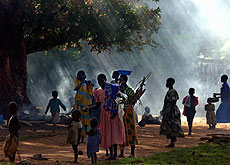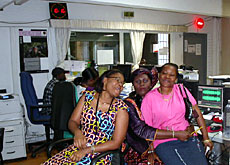SDC deplores humanitarian crisis in East Africa

Northern Uganda and eastern Congo are in the grip of a "dramatic" humanitarian situation, says the Swiss Agency for Development and Cooperation (SDC).
Hansjürg Ambühl, head of the SDC’s Africa humanitarian aid division, has just returned from a trip to the region to assess its needs and decide how Switzerland can help.
Ambühl spent a week in the provinces of Kitgum and Gulu in northern Uganda, before travelling on to Bunia in the Ituri district of the Democratic Republic of Congo.
He said that in northern Uganda the rebel Lord’s Resistance Army was terrorising the local population by carrying out attacks against women and children.
The group is embroiled in a 19-year-conflict with government forces, which has led to almost two million people fleeing their homes.
“The United Nations humanitarian coordinator, Jan Egeland, has said that the situation [in northern Uganda] is the biggest and worst humanitarian forgotten crisis in the world,” Ambühl told swissinfo.
He added that the rebels often kidnapped children, forcing them into sex slavery or to join their forces.
As a result, “night commuters” – around 30,000 children who come from the villages to sleep in towns to avoid LRA attacks – have become commonplace.
The SDC representative, who is “very concerned” about the situation, said that the Swiss government was contributing to aid efforts by UN agencies and non-governmental organisations.
He added that Switzerland would continue its support in the region. The agency has also decided to cooperate with the UN children’s organisation, Unicef, to improve child protection.
Deteriorated
Ambühl said that the situation in eastern Congo, which is plagued by violent militia groups, was not much better.
There are regular confrontations with the UN peacekeeping force, Monuc, which is stationed in eastern Congo – the last being the killing of nine Bangladeshi soldiers by militia forces in February.
Ambühl says the situation has deteriorated since January. An additional 100,000 people are living in four camps in the region, and some are hiding in the bush, making it harder for aid workers to gain access to them.
He said that these workers were faced with a difficult and dangerous environment.
“The UN actually wants them to travel with military protection,” he told swissinfo.
“That has very complicated implications because it confuses mandates and perceptions among the population and the militias, so humanitarian actors can, at any moment, become militia targets,” Ambühl said.
Apart from providing assistance, some of the Swiss projects in the region also focus on violence against women and children, one of the area’s biggest problems.
One campaign “non à la violence, non au viol” (no to violence and rape) offers support and counselling to victims and aid workers. Ambühl said that there was now a greater interest in the issue.
He said he was also greatly encouraged by the solidarity and care shown by local NGOs and groups.
Political solution
But Ambühl warned that a political solution needed to be found soon and that more efforts were needed on both national and international levels.
“International assistance should be stepped up and made more clear,” said Ambühl. “Monuc should be enhanced – the UN has deployed all the means it has in eastern Congo and it’s still not sufficient,” he added.
He said that although there has been criticism of Monuc – some peacekeepers have been caught up in a sex scandal – the population say the forces are necessary.
“They say with Monuc, we are not coming to paradise, but it will not be hell,” said Ambühl.
Another worrying factor for the region is the erosion of values in the conflict-torn area, which Ambühl describes as “what was wrong yesterday, is right today”.
He said it was hard to envisage peace and stability coming to the two areas in the near future.
“Even if there is a political solution, the humanitarian problems will remain,” he told swissinfo.
“People are traumatised, returning to places that have been destroyed. Children have had no education, so the need for humanitarian assistance will remain for quite some time after negotiated peace – maybe another five years.”
swissinfo, Isobel Leybold-Johnson
DR Congo: Population: 54.4 million; life expectancy: 41-43 years; GNI per capita: $100.
Swiss aid to DR Congo: SFr5.4 million ($4.5 million).
Uganda: Population: 26.7 million; life expectancy: 45-47 years; GNI per capita: $240.
Swiss aid to Uganda: SFr3 million.

In compliance with the JTI standards
More: SWI swissinfo.ch certified by the Journalism Trust Initiative


You can find an overview of ongoing debates with our journalists here. Please join us!
If you want to start a conversation about a topic raised in this article or want to report factual errors, email us at english@swissinfo.ch.